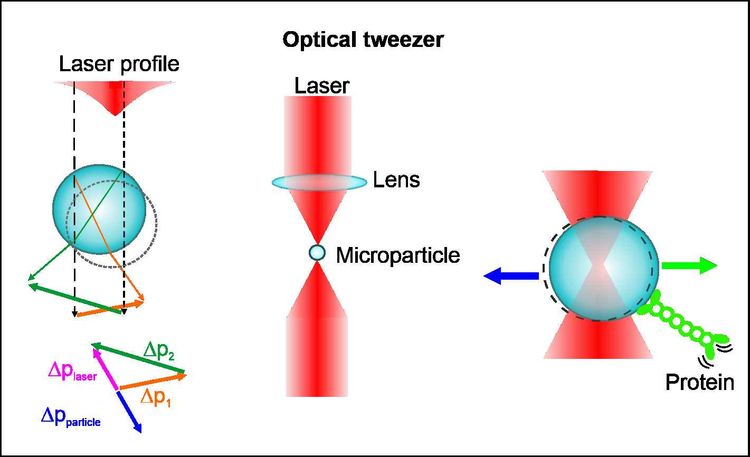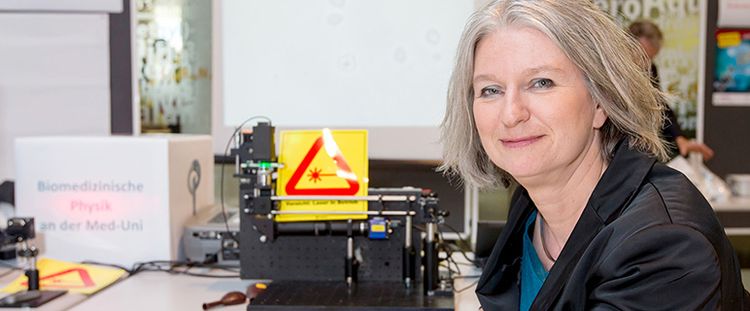For this year's contribution on women in physics, I came across Monika Ritsch-Marte while searching for an Austrian female physicist. Ritsch-Marte, Director of the Institute of Biomedical Physics at the Medical University of Innsbruck, works, among other things, on optical tweezers, for which Arthur Ashkin was awarded the 2018 Nobel Prize in Physics.
From theoretical quantum physics to applied optics
Already as a child, she was fascinated by light. At the age of 18, Ritsch-Marte, who was enthusiastic about science, decided to study physics at an open day at the University of Innsbruck. She graduated in 1984 with a degree in theoretical physics and shortly thereafter was given the opportunity to pursue her doctoral studies in quantum optics in New Zealand. During her doctoral work, Ritsch-Marte focused on the generation and applications of laser light with quantum mechanical properties. It was not until 1998, when she accepted the chair of Medical Physics at the Medical Faculty of the University of Innsbruck, that she switched from theoretical quantum physics to applied optics with special focus on laser applications in biomedical research.
The optical tweezers
During the summer time, when we are lying in the sun, we realize how much energy sunlight has as it gets hot very fast. Because of that, light can also be used to manipulate objects in the micrometer and nanometer range. But how does it work?
Sunlight consists of rays of light of several wavelengths (colors) traveling in different directions in space. In a monochromatic laser, the light has only a single wavelength and the direction of propagation is also limited.
In order to trap a microparticle with light, it must be transparent in the wavelength of the employed laser. This means that the laser light must go through the particle. During this process, the light is refracted at the interface between air and the particle and therefore its propagation speed and direction, and thus, its momentum changes. The momentum decreases at lower velocities and describes how an object moves. Because of this change in momentum of the light, and because of energy and momentum conservation - energy and momentum cannot be lost or created, only transferred - the momentum of the particle also changes. Thus, the deflected light beam exerts a force on the particle.

Let's have a look in detail at what happens. In the picture above, a spherical microparticle is shown, upon which a laser beam acts on. Intuitively, we would expect the laser beam to push the particle down, much like pushing a ball with a jet of water. In principle, that's what happens here, and the light pushes the particle ahead of it due to the radiation pressure. But in this way, nothing can be held in one place. For that, you need yet another force, which is created by changing the direction of the refracted light. To create the optical tweezer, the laser beam is additionally focused by means of a lens. The focusing is also a result of light refraction, which can be tried outside in summer with the sunlight and a magnifying glass. In the focus of the lens, where the laser beam is focused almost to one point and has the highest intensity, a trap is created for the microparticle, see picture on the far left. If the microparticle is not centered with respect to the beam, different momentum changes (shown as delta p1 and delta p2 in the image) will occur on opposite sides of the particle, depending on the intensity of the laser beam. This is shown with the green and orange arrows. The total change in momentum of the laser beam (magenta arrow) is the sum of the two individual changes, resulting in a change in momentum to the upper left. Due to conservation of momentum, the particle thus experiences a change in momentum to the lower right (blue arrow). It is thus drawn back to the center of the beam - to the point of highest intensity.
Several years after the discovery of the optical tweezers in 1985, living organisms such as viruses and bacteria could also be manipulated. It is important that the intensity of the laser is low enough not to destroy them. Infrared light (with a wavelength above 800 nanometers) is used to avoid absorption and bacteria damage. By docking proteins to nanoparticles held in place with optical tweezers, it is possible to track the movement of the proteins as shown in picture on the far right.

Development of applied optics
As part of the European Research Council 2010-2015 project catchIT (Coherently Advanced Tissue and Cell Holographic Imaging and Trapping), Ritsch-Marte achieved the manipulation of microorganisms through an advancement of the optical tweezers. For this, she employed a mirror technique and created the optical macro tweezers to be able to catch and move objects and living organisms in the sub-millimeter range.
A central theme in her research group is the various uses of light in medicine and biomedical research. Here not only basic research plays an important role, but also concrete medical applications, such as fighting brain tumors through light irradiation.
Her work has also proved successful in the further development of microscopy methods. For example, her group is researching a method that does not only improve the resolution and contrast enhancement of light microscopy, but also facilitates switching between different microscopic techniques. Her group has also developed a variant of Coherent Anti-Stokes Raman Scattering (CARS) microscopy that uses vibrational resonances of different molecules to identify chemical compositions. This provides, for example, the ability to distinguish between saturated and unsaturated fat acids in cells.
Active promotion of women
For whole four years, Ritsch-Marte was the only female physics professor at an Austrian university. At first, like many of us, she was against the women's quota, but she soon realized how important it is to promote women through this opportunity. During her career, she was very active in the advancement of women in physics: together with the theoretical physicist Claudia Draxl (professor at the Humboldt University in Berlin), she headed the working group "Women in Physics" of the Austrian Physical Society (ÖPG). On the occasion of Lise Meitner's 130th birthday in 2008, she initiated during her time as president of the ÖPG, together with Barbara Sandow, the well-known Lise Meitner Lectures, which are held annually and where outstanding female physicists can present their work to the public. Mildred Dresselhaus gave the first lecture at the Lise-Meitner Lectures in 2008.
In an article she published with Claudia Draxl back in 1996, they described their experiences as female physicists in a male-dominated field. The article named "Dear Sir...", gives a very interesting insight into the society 40 years ago. When asked, she said there was still a lot of work to be done, but in the meantime, women are fortunately no longer exotic in physics. (Andrea Navarro-Quezada, 8.3.2021)
More articles in this blog
- Gallium nitride: the allrounder among semiconductors
- Why CO2 is heating up the earth
- How to make ice cream with liquid nitrogen